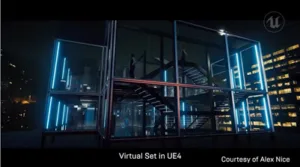In today’s installment, I continue to offer a preview ‘sampling’ of some of the most intriguing VR, virtual production, and virtual event use cases slated as presentations for SXSW Online, along with some supporting video exemplars. In the previous article in this series, I took the reader on a short tour of VR-related use cases emerging from the upcoming SXSW conference.

One of the most predictive technology conferences today is the world-renown SXSW conference, a conference that specializes in the future. At SXSW, VR has always had a nice footprint, and this year no different. This year, due to the Rona, the traditional face-to-face SXSW Conference & Festival is being replaced, at least in part, with a completely virtual version called SXSW Online. SXSW Online is scheduled for March 16 – March 20, 2021 and will offer more than 230 distinct conference sessions.
In the hopes of providing our reader with a revealing snapshot of future trends being showcased at SXSW Online, I have summarized below a few of the most germane sessions.
Production
There are two SXSW sessions in the virtual planning/production arena that draw immediate attention. The first is a session entitled “Lessons from the Front Lines of Virtual Production” which covers how more than “165 productions of all shapes and sizes, from The Mandalorian to The Witches, are taking advantage of real-time game engine technology to achieve greater creative collaboration while saving time and resources”. This session will help attendees learn about cutting-edge methods like virtual location scouting, real-time character animation, and live in-camera effects with LED walls. It also aims to help attendees learn how virtual production techniques can be adopted “by any department on set, even on smaller-budget productions”. This video highlights the session’s content:
A second session, entitled “Virtual Planning for a New World of Streaming Entertainment”, is being conducted by The Third Floor and offers a deep dive on helping “creative producers use the virtual world to explore story ideas, visualize sets and characters, define shots and technical approaches ahead of time and inform every aspect of the shoot”. Presenters plan to demonstrate “techniques in virtual scouting and virtual camera, VR- and AR-based visualization.”
This video tells the story:
Virtual Events
Two sessions in this category are highly appealing. First, a presentation entitled “Art House Distribution in the Age of Covid” aims to showcase how film distributors are developing work arounds to provide cinema experiences to audiences outside of traditional brick-and-mortar venues. The goal of this session is to address “how virtual cinema will be incorporated going forward into any film’s theatrical plans, in addition to, or instead of a “popcorn + butter” release”. The session also plans to cover how distributors and producers can expand their audience via virtual cinema.
A second compelling SXSW session entitled “No Spectators: Community-built Virtual Multiverses” addresses how humans can interact on build their own virtual lands when physical experiences are cancelled due to Covid. Examples are plentiful:
- Burning Man, the contra-culture community built eight virtual versions of its temporary city in Nevada – from 2D to a high tech photorealistic VR city.
- C2 Montreal, known for reinventing the tech conference experience, served as a platform for thousands of one-to-one and one-to-many conversations proposed by its virtual attendees.
- The band Courier Club hosted a music festival inside Minecraft with over 5000 gamers.
See this video for purposes of clarity:
Video
VR on the Edge
Two final provocative sessions caught my eye, and are worth coverage here. A session entitled “Indigenous Storytellers: New Tech, Timeworn Tales” addresses the need for indigenous people storytelling through the medium of XR. According to session organizers, “When people speak of underrepresented communities, indigenous people are often left out of the conversation”. This session brings together a panel of successful women who are using the power of immersive technologies and game development to “share the history and correct the misconceptions around indigenous people” and foster greater understanding of marginalized groups. See the video below as an example from the user’s point of view:
A last session, entitled “Eyes off the Road! Universal’s Drive for In-Car VR”, is also likely to draw loads of attention with a remarkable focus on journey-based XR experiences. This session predicts that autonomous vehicles will render the “moving living room” a reality and change the way we consume entertainment while on the go. To quote session organizers,
“Universal has collaborated with German startup, Holoride, and real-time spatial experience company, REWIND, to shape the in-car entertainment experience of the future. Working with REWIND, Universal is reimagining beloved IP in VR. Holoride technology takes that VR content and matches it with data points from the vehicle in real-time, creating an extremely immersive experience that also helps to reduce motion sickness. The content is highly adaptive and matches the type and length of the route”.
Don’t miss this video of Holoride in action:
The following teaser shows some of the inside filming work as well:
The hope is that journey-based XR experiences will offer a new medium (and challenges!) for creatives and new revenue opportunities for many companies. Interestingly, this session also promises to shed light on the neologism “elastic content”. This term may have something to do with the notion expressed above, when “content is highly adaptive and matches the type and length of the route”. We’ll have to attend the session to find out more.— Len Scrogan

